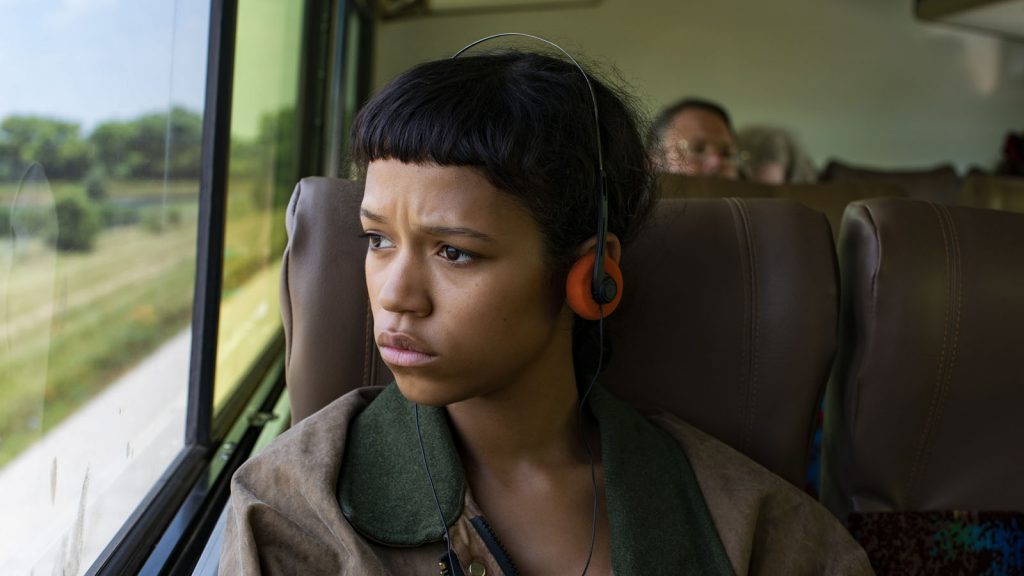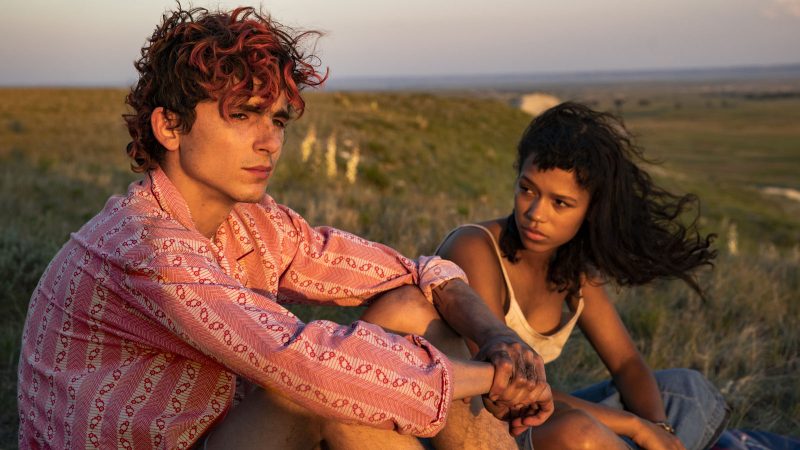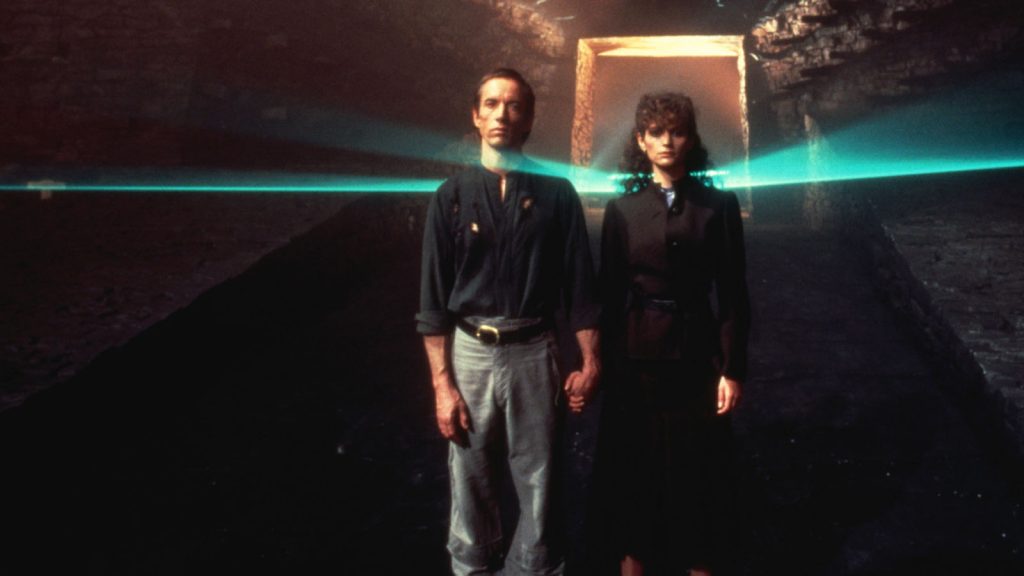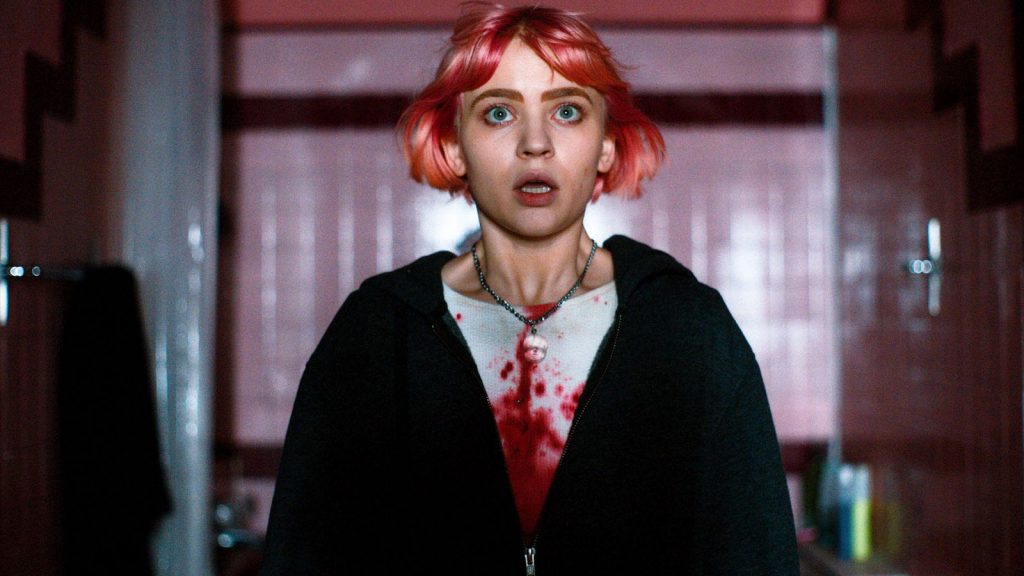Bones and All—Luca Guadagnino’s latest monument to ill-fated love, based on the 2016 young-adult novel by Camille DeAngelis—begins with a slice of the quotidian: somewhere in small-town Virginia, a roomful of teenage girls go about the late-night business of painting their nails. Among them, the soft-spoken Maren (Taylor Russell) lies nestled under a glass coffee table beside her friend. For a moment, Maren admires the girl’s freshly manicured hand and caresses a finger; then, unexpectedly, she draws the digit to her mouth and cleanly rips the flesh from the bone. When she returns home, half-dried blood smeared across her mouth and pajamas, her father, Frank (André Holland), springs into action, not with surprise or even anger, merely measured disapproval. “You didn’t…?” He sighs, the kind of gesture any father might hoist upon a child who has failed to meet more classical standards of agreed-upon conduct: high grades, honored curfews, etc.
He abandons her in Maryland with a modest inheritance: some cash, her birth certificate, and a cassette tape, both sides full with his weary account of her deathly propensities from infancy (there are buried and missing bodies, but Maren remembers nothing). Easily the most precious of these treasures is the birth certificate, graced with the name and birthplace of the mother she never knew. Maren sets off to find her, and along the way encounters fellow “eaters.” First, she stumbles across Sully (Mark Rylance), a bizarre drifter who, quite literally, sniffs her out (as eaters evidently can do). He has a curious habit of referring to himself in the third person, and in addition to a khaki vest, its lapels festooned with glittering butterfly brooches, he dons a fedora decked with a lone feather and slicks his hair into a thin braid. As if all this was not enough clumsily (and questionably) coded indigeneity, he keeps as a souvenir the hair of his victims, woven into a bloody braid—several feet long—and folded in his briefcase. Naturally, Maren flees his presence at the earliest opportunity and runs almost directly into Lee (Timothée Chalamet), the flame-haired waif who eventually becomes her companion.

Much of the film is devoted to the charismatic cannibal lovers on the run, with express deference to Terrence Malick’s Badlands (1973) and artful traces of Days of Heaven (1978). But Guadagnino seems most interested in the aesthetic gifts the American landscape makes available: faded block initials announce each state, and though Maren guides us through Virginia, Maryland, Indiana, Kentucky, Minnesota, and Nebraska, each place is indistinguishable from the last, all blades of green and winding narrow roads that hug the length of seemingly boundless pastures. Every lush, sparsely populated hamlet preserves a conventionally whimsical portrait of the pastoral Midwest, with none of its pesky politics to sully the reverie—apart, perhaps, from the occasional homophobic slur. The biracial Maren somehow endures only the most polite interactions, or, at worst, inspires mild concern.
It has long been Guadagnino’s pattern to risk ideological coherence in pursuit of glamor; consider the wobbly political scaffolding of Suspiria (2018) or the ambivalent queerness in his HBO television series We Are Who We Are (2020). He takes beauty seriously enough to be scrupulous about it, and here he has enlisted the prodigious talents of wunderkind cinematographer Arseni Khachaturan, architect of the lavish photography in Eyimofe (This is My Desire) and Beginning (both 2020). Bones and All succeeds largely, then, as an expressively shot, familiarly sentimental tale, in no small part thanks to Guadagnino’s intuitive romanticism. He can always be relied upon to compose a stylish vision—one that seduces viscerally while disguising negligence elsewhere.
Bones and All marks the director’s third feature collaboration (comprising two very loose remakes and now one adaptation) with screenwriter David Kajganich, after A Bigger Splash (2015) and Suspiria; the same core asymmetry that haunted the latter plagues this latest effort. A confession from Lee about his past comes far too late to offer any meaningful insight into the character or plot, which boasts no less than three false endings. The film proves peculiarly sheepish, too, where it might’ve more graphically delivered on the promises of its premise. Such ripe ingredients as cannibals, wayward lovers, and the American “heartland”—dense with lineage across genres and winsomely staged here—do not quite amount to the seditious tale Bones and All might have been, or clearly, in some ways, hopes to be. To be sure, the film could have used more devotion to its grisly conceit (although what gore exists is adequately chilling), but even the symbolism does not always land smoothly.

Without question, cannibalism operates here, above all, sexually. Already a highly intimate exercise, it also becomes for eaters a bonding act, at times to their chagrin—thus, some of the queer subtext feels inevitable. It’s the 1980s; there is a glimpse of Rudy Giuliani, and Reagan lingers menacingly in the margins (whether he appears or not), as he does in so many other ’80s revivals. But the film clearly reaches for these overtures, too, in Lee’s androgyny and Sully’s dialogue (loaded with unsubtle allusions) about their “nature” and its requirements, and in the persistent generational disconnect that so thoroughly shapes these cannibals, all effectively orphaned by their parents, who may or may not have bequeathed them this condition in the first place. These gestures at queerness appear almost entirely cosmetic, however, further troubled by some clumsy storytelling. Whenever that sexuality threatens to become in any way explicit, it turns violent: when Maren takes her friend’s finger into her mouth only to bite it off, or when Lee has sex with a man only to slash his throat so that he and Maren can feed. This last incident is brought into even murkier terrain when the couple discover that their victim was married with two children.
In fact, Guadagnino’s oeuvre is somewhat characterized by (at times frustratingly) elusive queerness. Amid all the breathless praise for Call Me by Your Name (2017), which made Chalamet a star, the film famously drew criticism from its own screenwriter, James Ivory, for muting its same-sex intimate scenes. Indeed, the pan-away shot to the trees during the lovers’ first moment of consummation feels especially retrograde now. And the two queer teens at the center of We Are Who We Are navigate—not unrealistically—foiled or toxic would-be romances only for the series to end on an apparently platonic kiss; it’s an admittedly complex and fascinating friendship, but desire or romantic satisfaction always seems just out of their grasp. All that said, it would be unfair to map queerness with certain “measurable” qualities—parameters that demand it be made visible or, perhaps more egregiously, legible. But it is hardly bold, especially now, to speak in metaphors, or revel in “symbolic” love that must inevitably culminate in tragedy.
Amid all these dangling ends, the film owes much to Russell, a compositionally refined performer who also squarely salvaged Trey Edward Shults’s (uncharacteristically) cumbersome Waves (2019). A character such as Maren, primarily an observer for long stretches, could have easily disappeared in her own narrative, but Russell anchors her in a central defiance that makes her effortlessly intriguing where the script does not. Chalamet, with far less to do, still commands the screen in a way so few of his peers seem able to manage; he and Russell share a sweet, old-fashioned chemistry (fit for the quaint, minimalist score by Trent Reznor and Atticus Ross), akin to that of the similarly doomed lovers in Nicholas Ray’s They Live by Night (1948). Apart from Chalamet, Guadagnino also reunites with Jessica Harper (the lead of Dario Argento’s original 1977 Suspiria and a bit player in Guadagnino’s remake), Chloë Sevigny (who appeared in We Are Who We Are), and Michael Stuhlbarg (Call Me by Your Name); all deliver, with visible relish, extravagant performances in their all-too-fleeting scenes that set a tone—lively and absurdist—from which the rest of the film woefully shrinks. This feels emblematic of Bones and All’s overarching misstep: brimming with so many rich elements, the film strangely longs to be so much quieter and smaller than the sum of its parts.

has a PhD in horror cinema and her work has been published in Film Comment, Reverse Shot, and MUBI Notebook, among others.
Consider Titane a reverse-slasher: not merely because in place of the usual murderous man-child in gender distress, fueled by psychosexual rage to terrorize mainly (or most enthusiastically) his female victims, we have a gender-bending...
BY KELLI WESTON | October 31, 2021
One need only watch a few moments of Peter Strickland’s films to realize that the British-born, Hungary-based director is a stickler for detail.
BY MARGARET BARTON-FUMO | June 24, 2022
Though she’s not generally counted among the canon of horror’s distinguished performers, perhaps none can boast a more sprawling and diverse corpus than Carla Gugino.
BY KELLI WESTON | May 9, 2024

This pre-Code offering packs a lot of story into its typically brisk running time, with several plot threads weaving together a (not always successful) tapestry of spooky and criminal doings.
READ MORE >
BY ANN OLSSON | Month 00, 2021

In what could be the fastest-resulting rape revenge movie, a drunken lout brutally forces himself on Ida, the young woman who doesn't return his affections, during a party over Labor Day.
READ MORE >
BY LAURA KERN | Month 00, 2021

Beast is a lot of movies in one package - fractured fairy tale, belated-coming-of-age story, psychological drama, regional horror film - but above all it's a calling card for its leading lady, Jessie Buckley.
READ MORE >
BY LAURA KERN | Month 00, 2021